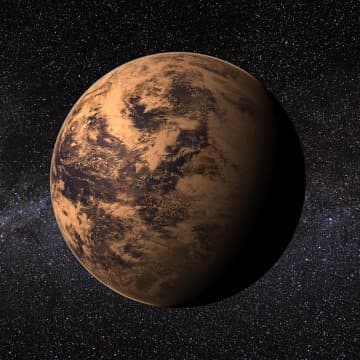
Artist’s conception of Gliese 667 Cc
Table of contents
Open Table of contents
Intro
Gliese 667 Cc also known as GJ 667Cc, HR 6426Cc, or HD 156384Cc is an exoplanet orbiting within the habitable zone of the red dwarf star Gliese 667 C.
Characteristics
| Property | Value |
|---|---|
| Planet type | Super Earth |
| Discovery date | 21 November 2011 |
| Discovered by | European Southern Observatory |
| Mass | 3.8 Earths |
| Planet radius | 1.77 x Earth |
| Orbital radius | 0.125 AU |
| Orbital period | 28.1 days |
| Eccentricity | 0.02 |
| Detection method | Radial Velocity |
| Star | Gliese 667 C |
Discovery
Gliese 667 Cc was first announced in a pre-print made public on 21 November 2011 by the European Southern Observatory’s High Accuracy Radial Velocity Planet Searcher (HARPS) group using the radial velocity method also known as Doppler method.
Host star
The planet orbits a red dwarf (M-type) star named Gliese 667 C, orbited by a total of two planets. Gliese 667 C has a mass of 0.31 M and a radius of 0.42 R. It has a temperature of 3,700 K
Habitability
Although Gliese 667 Cc is located in a habitable zone, the conditions on the planet could be very different from our Earth. Life would be facing some potential challenges, which may include low and varying light conditions, possibly a higher atmospheric pressure, and violent flares.
The planet is likely tidally locked, with one side of its hemisphere permanently facing towards the star, and the opposite side being dark and cold. We can only speculate how fauna and flora, if present at all, would evolve under such different conditions.
If the composition of its atmosphere is similar to Earth it may well have surface temperatures of around 30C (86F). This would allow for the presence of liquid water which makes Gliese 667Cc an exciting prospect in terms of habitability.

Artist’s conception of Gliese 667 Cc
Outro
A similar atmospheric composition to Earth would produce temperatures slightly higher than on Earth, a thicker atmosphere may produce a runaway greenhouse effect. With a similar atmosphere and composition to Earth it is possible life could exist on Gliese 667 Cc.
It’s important that Gliese 667 Cc is considered a potentially habitable exoplanet, its habitability and the presence of water or life are still speculative.